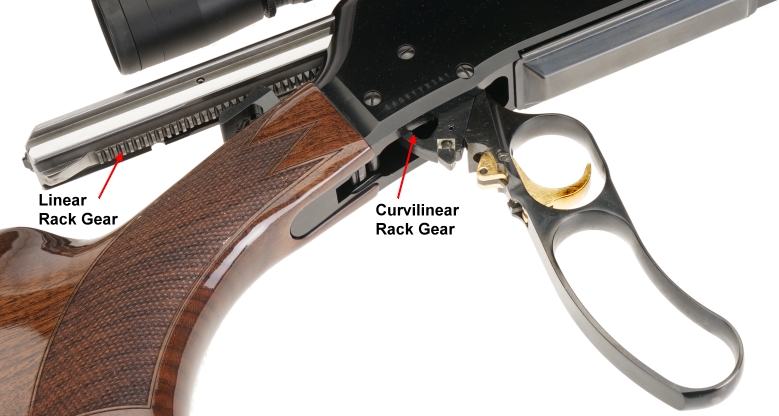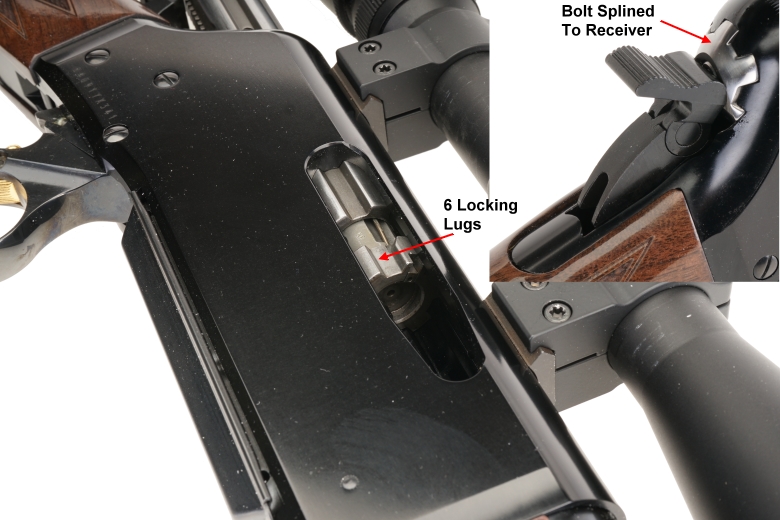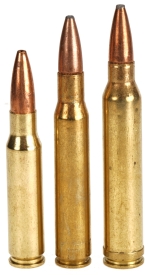 11/26/2023 – Some day I will take the time to write about the Browning family, particularly those involved in gun making. Yes, they were generations of famous gun designers and gun makers, but they also were philanthropists, deeply involve in serving others out of faith, but also out of a sense of social responsibility. Good people.
11/26/2023 – Some day I will take the time to write about the Browning family, particularly those involved in gun making. Yes, they were generations of famous gun designers and gun makers, but they also were philanthropists, deeply involve in serving others out of faith, but also out of a sense of social responsibility. Good people.
| Browning Lever-action Rifle | |
| Item Number | 034009126 |
| Manufactured | Miroku, Japan |
| Type | Lever – Long Action |
| Caliber | 30-06 Springfield |
| Barrel Length | 22″ Sporter Contour |
| Rifling Rate of Twist | 1:10″ |
| Barrel Finish | Polished Blued Steel |
| Receiver | Anodized Aluminum Alloy |
| Magazine | Detachable – 4 Rounds |
| Overall Length | 43″ |
| Stock | Black Walnut – 18LPI Checkering |
| Length Of Pull | 14 1/4″ |
| Drop At Comb | 1″ |
| Drop At Heel | 1″ |
| Sight Mounts | Receiver Drilled and Tapped |
| Sights Front/Rear | Ramped Bead / Open Adj, W&E |
| Rifle Weight – Empty | 7 Lbs 4 Oz |
| MSRP | $1,249.99 |
Val Browning, was the son of Jonathan Browning, and the grandson of John Moses Browning. John Moses Browning designed the Winchester Model 1895 lever action rifles to handle cartridges such as the 30-40 Krag, 30 Government and 405 Winchester, all moderate pressure cartridges, but significantly more than black powder or early smokeless powder cartridges.
Val Browning, in collaboration with FN personnel, designed the Browning BLR. The Browning Lever-action Rifle was introduced and manufactured in Belgium in 1971. In 1972, manufacturing was moved to Miroku in Japan.
The presence of a lever is incidental
The Browning BLR is gear actuated, rather than by levers or toggles, and it is devoid of a falling breech block. The BLR contains two rack gears, one linear integrated into the underside of the bolt, the other, a curvilinear type, is integrated into the rifle’s lever. A double, straight cut pinion, converts the lever’s radial motion, into the longitudinal movement of the bolt.
I did not disassemble the BLR to photograph all of the salient pieces. The last time I did that, it took two day for semi skilled me to correctly reassemble and time the rifle. Besides, Browning has a heck of a detailed illustration on their site.
Pardon the shop dandruff…
When winter brings the shop stove online, we hack and cough while a year’s worth of shop dust gets picked up by filters and vacuums. The important thing is, the BLR has a flawless black finish, the specks of dust belong to us.
So unlike the breech block design of the Marlin 336, Winchester 94 or their derivatives, the Browning BLR has a six lug rotating bolt head that locks up into a barrel extension, enclosing a cartridge case head. In addition, the bolt is splined to interlock with the receiver.
Testimony to the Val Browning design? The BLR is strong enough to be, or has been, chambered in: 22-250 Rem, 222 Rem, 223 Rem, 243 Win, 270 Win, 270 WSM, 30-06 Spfld, 300 Win Mag, 300 WSM, 308 Win, 325 WSM, 358 Win, 450 Mar, 6.5 Creedmoor, 7mm Rem Mag, 7mm WSM, 7mm-08 Rem. Within this collection of cartridges, there are chamber pressures in excess of 63,000 psi. The BLR is really a bolt action rifle that substitutes a lever for a bolt handle.
A folding hammer
The Folding Hammer has four positions: Full cock and ready to fire, half cock safe, half cock with the hammer folded into the receiver for drop safe, and the full forward fired position. Nifty solution for hammer block.
Hunter’s magazine capacity
The Browning BLR has a detachable staggered, box magazine that holds 4 rounds. With one in the chamber, that is 5 rounds for a hunter. I am not sure how we have gotten to a point in time when people think no rifle should hold less than 10, and preferably 20 rounds of ammo.
Unless a hunter belongs in a remedial marksmanship class, or they intentionally attempt shots beyond their shooting ability, the 5 round capacity is already 4 in excess, 3 if I am being generous. Are there settings where high magazine capacity makes sense? You bet, but big and medium size game hunting is not one of them.
The detachable magazine makes loading and unloading a simpler task, it is out of the way of hands, and it allows carrying spare or different ammo in a coat pocket. It also means a lever action that does no require flat or round nose bullets.
Why the 30-06 Springfield? Glad you asked…
Left L-R: 308 Winchester, 30-06 Springfield, 300 Winchester Magnum. A selection of just three of the available Browning BLR chambers. Essentially, any of these three are solid for any North American game in the hands of a competent hunter.
For me, the 308 Winchester does not match the power or range of the 30-06 Springfield in factory ammunition or handloads, and returns little for the compromise.
The 30-06 Springfield has 20% greater powder capacity, operates at only 2,000 psi lower pressure and is chambered in long action firearms. The latter is important because bullets can be seated out to take up less powder capacity.
| Hornady Superformance | Bullet Weight Grains |
Muzzle Velocity FPS |
Drop ” @300 Yards |
| 308 Winchester | 165 | 2840 | -7.6 |
| 30-06 Springfield | 165 | 2960 | -6.9 |
| 300 Winchester Magnum | 165 | 3260 | -5.5 |
The 300 Winchester Magnum does provide greater power and range than the 30-06 Springfield. However, those benefits come with the penalties of significantly heavier recoil and muzzle blast and, to some degree, an excess of power for most North American game. Drop @300 Yards, as they appear on the table, are based on a 200 yard zero.
Ultimately, the cartridge selection within this review is mine alone, as there are sixteen other calibers as alternatives for the BLR.
Accuracy, precision, group size…
The shop schedule, such as it has been as of late, did not allow for handloading. However, there was time to work with some factory Remington Express Core-Lokt 150 gain and 180 grain ammunition. Clocking 2945 fps and 2732 fps respectively over the chronograph, the 150 grain load shot a 1.3″ 5 shot group. The 180 grain load shot 1.1″.
From the Real Guns Ballistic Calculator:
| Best Zero Results 150 Grain Core-Lokt | |||||||
| Near-Zero – yards. | 26 | Mid Range – yards. | 136 | ||||
| Far-Zero – yards. | 238 | Max Ordinate – “ | +3.0 | ||||
| Point Blank – yards. | 253 | ||||||
| Yards | 0 | 50 | 100 | 150 | 200 | 250 | 300 | |||||
| Velocity – fps | 2945 | 2795 | 2649 | 2508 | 2372 | 2240 | 2113 | |||||
| Energy – ft.-lbs. | 2888 | 2601 | 2337 | 2095 | 1874 | 1671 | 1487 | |||||
| Momentum – lbs-sec | 63 | 60 | 57 | 54 | 51 | 48 | 45 | |||||
| Path – “ | -1.50 | 1.13 | 2.66 | 2.94 | 1.84 | -0.81 | -5.19 | |||||
| Drift – “ | 0.00 | 0.00 | 0.00 | 0.00 | 0.00 | 0.00 | 0.00 | |||||
| Time Of Flight – sec. | 0.00 | 0.05 | 0.11 | 0.17 | 0.23 | 0.29 | 0.36 | |||||
Essentially, the 150 grain load has a 250 yard point blank range. The trajectory of the bullet does not rise above, or fall below, line of sight by more than 3″ in either direction, out to 250 yards.
Notes to end on…

My personal preference is the subject rifle, with curved pistol grip. Unless a a lever action is carbine length, and close to 6 lbs for easy carry, I would rather have a steadying grip to hold onto. However, Browning offers a variety of BLRs.
There are currently four versions of the Browning BLR: 1) BLR Lightweight, black, with curved pistol grip, 2) BLR Lightweight, stainless/nickel anodized receiver, with curved pistol grip, 3) BLR Lightweight ’81, black, with a straight stock, 4) BLR Lightweight ’81 Stainless Takedown.
Regardless the configuration, the mechanical advantage of the rack and pinion system makes for a short, smooth and easy lever throw. Feed is flawless, as is ejection.
The BLR carries a bit of weight at 7 1/4 lbs. Easily over 8 with a scope mounted. That said, the weight takes the edge off of 30-06 Springfield recoil, and makes recovery, if setting up for a second shot, much faster.
At a point in firearm manufacturer where poly stocks and Cerakote finishes are the norm, the Walnut stocked Browning, with anodized and blued hardware is a welcome bit of class. Nice rifle.
Epilog – Opinion
I read an article that began by saying the design of the Browning BLR was a collaborative effort with Val Browning and the FN factory employee Karl Lewis. By the next paragraph, the author dismissed Browning and went on to credit Karl Lewis.
The articles does not track with other historical work by David Miller or Joseph Cornell. Maybe Gangarosa’s book is correct, and it was a collaborative effort. That does not support the article stripping one team member of accomplishment and designating another as the sole creative resource. Val Browning 1895 – 1994, held 48 firearm patents and carried on where his father left off. I am pretty sure he deserves some credit.






Joe, I have 4 Lightweight 81’s with straight stocks. The most common is in 308, with ammo readily available, as well as brass and bullets. Primer’s not so much and the 308 is not picky on powder selection. My other 3 are in 325 WSM, 358 Winchester, and 450 Marlin, all of which I handload for when I can find the brass. Of course one can neck up 300 WSM brass for the 325 and 308 brass for the 358. Hornady seems to have abandoned the 450 Marlin leaving me with about 100 true 450 cases. I have been successful making cast bullet loads using TrailBoss powder, Large Pistol primers, and shortened 300 Win Mag brass salvaged from the local range. I know the belt is not as thick as on the Marlin case, but the light fun loads work well in the 81, as well as my Ruger #1 and Handi Rifle. I always enjoy your articles. Bob!
Thanks, Bob. That is quite an array of chambers, and good ones at that. The current trend in manufacturers going obsolete so quickly seems to be accelerating. I had to scrounge to get 375 Ruger brass, and Ruger just announced a product with that chamber. It is particularly tough on folks who buy newer cartridges, invest in firearms and supporting material as you have, only to find they can no longer get brass.
I noticed a good number of bullet, weights and calibers are listed by those manufacturers, but pared off the list of on line retailers. Folks like yourself will always find a way to make it work.
Joe